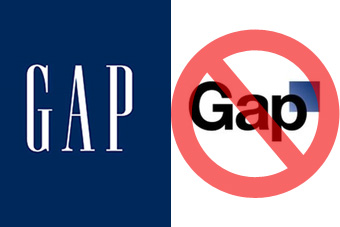Love it or hate it, the social media phenomenon has had a massive—personal and professional—impact on all of us and you can not fail to be impressed by its reach for spreading new ideas and building profiles. And, in a brand context, there are currently some great creative campaigns out there. We particularly like the new initiative from Nestle Australia—via Facebook and YouTube—for the Smarties confectionery brand. The ‘Smarties 8 Colours of Fun’ project is looking at “How many colours does creativity have?” and the brand has invited eight artists from a mix of fields to team up with eight imaginative kids to carry out the same number of themed art projects, dedicated to one of the chocolate dragée colours. Watch the videos here.
The power of community, the collective, the collaborative… a brand marketer’s dream. Yes, but, we should not put the power of the crowd over and above our expertise when it comes to brand identity and brand value. The debacle of ‘Gap-gate’ and its abandoned attempt to re-brand led Marka Hansen, President of Gap North America, to explain, “this wasn’t the right project for crowd sourcing.” A timely reminder that the new move towards consumer participation—and particularly consumer designed logos and identity—does not necessarily point towards a new era of democratic brand design. Instead it should make us stop and think about the validity and desirability of the new trend for following the crowd and begs the question, ‘Does brand design really need to be so democratic?’

Image sourse: just-style.com
The problem is regardless of whether and where this sort of collaboration has succeeded or failed, we have come to expect, anticipate and invite this kind of dialogue with brands. In an attempt to foster love and connection with the consumer, it’s easy to see why many brands have gone down the people power route in terms of brand behaviour and future direction. But, where does the buck stop? We demand to be included in the process, asking questions and expecting to be answered, to see evidence that our ideas are being listened to…
But, we are not afraid to pillory if we don’t feel that the end product is quite right…Seemingly, there is no easy or immediate answer to this one and, as technology advances, the growing tussle between brands and their audience makes us question how future generations will expect the relationship to work.
As a way of evolving brands and bringing new initiatives to life, brands should embrace and integrate all on and offline marketing routes and the different audiences that these varying mediums connect with. But what brands—and the agencies they work with—really must do is reinstate their brand leadership with conviction in their ideas, ideals and expertise. It is often human nature to reject what is new but when created through thorough strategy and thoughtful brand design it is this expertise that creates our future.
As boundaries blur, the fact that we are all the audience, does not mean that we should all be the brand designer.
About the Author
Jonathan Ford is a designer and co-founding partner of Pearlfisher. He oversees a portfolio of award-winning designs, including a high profile list of ethical, entrepreneurial and iconic brands. He is also a frequent speaker at high-profile international industry events and regular contributor and commentator in the design and brand press.
Jonathan can also be followed on Twitter—@Jforddesigns
